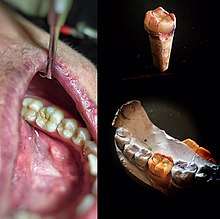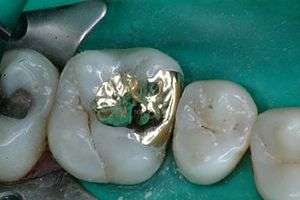Inlays and onlays
| Inlays and onlays | |
|---|---|
| ICD-9-CM | 23.3 |
| MeSH | D007284 |

In dentistry, an inlay is usually an indirect restoration (filling) consisting of a solid substance (as gold, porcelain or less often a cured composite resin) fitted to a cavity in a tooth and cemented into place.[1] This technique involves fabricating the restoration outside of the mouth using the dental impressions of the prepared tooth, rather than placing a soft filling into the prepared tooth before the material sets hard.
An onlay is the same as an inlay, except that it incorporates a replacement for a tooth cusp by covering the area where the missing cusp would be. Crowns cover all surfaces of the anatomical tooth crown.
An easy comparison between Inlays and Onlays can be their positioning. An Inlay mostly involves pits and fissures of the anatomical crown and not necessarily the cusps. While an Onlay involves the cusps and cuspal tips majorly.
Inlays
Sometimes, a tooth is planned to be restored with an intracoronal restoration, but the decay or fracture is so extensive that a direct restoration, such as amalgam or composite, would compromise the structural integrity of the restored tooth or provide substandard opposition to occlusal (i.e., biting) forces. In such situations, an indirect gold or porcelain inlay restoration may be indicated.
Comparison of inlays and direct fillings
When an inlay is used, the tooth-to-restoration margin may be finished and polished to a very fine line of contact to minimize recurrent decay. Opposed to this, direct composite filling pastes shrink a few percent in volume during hardening. This can lead to shrinkage stress and rarely to marginal gaps and failure. Although improvements of the composite resins could be achieved in the last years, solid inlays do exclude this problem.[2] Another advantage of inlays over direct fillings is that there is almost no limitations in the choice of material. While inlays might be ten times the price of direct restorations, it is often expected that inlays are superior in terms of resistance to occlusal forces, protection against recurrent decay, precision of fabrication, marginal integrity, proper contouring for gingival (tissue) health, and ease of cleansing offers. However, this might be only the case for gold. While short term studies come to inconsistent conclusions, a respectable number of long-term studies detect no significantly lower failure rates of ceramic [3] or composite [4] inlays compared to composite direct fillings. Another study detected an increased survival time of composite resin inlays but it was rated to not necessarily justify their bigger effort and price. [5]
Onlays
When decay or fracture incorporate areas of a tooth that make amalgam or composite restorations inadequate, such as cuspal fracture or remaining tooth structure that undermines perimeter walls of a tooth, an onlay might be indicated[6]. Similar to an inlay, an onlay is an indirect restoration which incorporates a cusp or cusps by covering or onlaying the missing cusps. All of the benefits of an inlay are present in the onlay restoration. The onlay allows for conservation of tooth structure when the only alternative is to totally eliminate cusps and perimeter walls for restoration with a crown. Just as inlays, onlays are fabricated outside of the mouth and are typically made out of gold or porcelain. Gold restorations have been around for many years and have an excellent track record. In recent years, newer types of porcelains have been developed that seem to rival the longevity of gold. If the onlay or inlay is made in a dental laboratory, a temporary is fabricated while the restoration is custom-made for the patient. A return visit is then required to fit the final prosthesis. Inlays and onlays may also be fabricated out of porcelain and delivered the same day utilizing techniques and technologies relating to CAD/CAM dentistry.[7][8]
A systemic review found that the most common cause of onlay failure is ceramic fracture, followed by ceramic de-bonding from the tooth structure, and the occurrence of secondary caries which is seen as a discolouration at the margins of the restoration. High failure rates were associated with teeth that had previous root canal treatment, and with patients who exhibit para-functional habits such as bruxism , or teeth clenching. [9]
References
| Wikimedia Commons has media related to Dental inlays. |
- ↑ NW Medical Guide
- ↑ Schneider et al.: Shrinkage Stresses Generated during Resin-Composite Applications: A Review; (2010); J Dent Biomech; vol. 1 no. 1 131630

- ↑ Clinical evaluation of ceramic inlays compared to composite restorations.; (2009); RT Lange, P Pfeiffer; Oper Dent. May-Jun;34(3):263-72. doi:10.2341/08-95
- ↑ Pallesen, U; Qvist, V. "Composite resin fillings and inlays. An 11-year evaluation. (2003)". Clin Oral Invest. 7: 71–79. doi:10.1007/s00784-003-0201-z.
- ↑ Dijken, JWV Van (2000). "Direct resin composite inlays/onlays: an 11 year follow-up". J Dent. 28 (5): 299–306. doi:10.1016/s0300-5712(00)00010-5. PMID 10785294.
- ↑ "Inlay-Onlay en composite". Le courrier du dentiste. November 2012. Retrieved February 2018. Check date values in:
|access-date=(help) - ↑ Masek R, Tsotsos S (October 2002). "Ultimate accuracy with correlation". Int J Comput Dent. 5 (4): 295–303. PMID 12736941.
- ↑ Masek R (January 2003). "Designing in 3D—a more visual approach to Cerec correlation". Int J Comput Dent. 6 (1): 75–82. PMID 12838591.
- ↑ "Longevity of ceramic onlays: A systematic review". BDJ. 224 (10): 787–787. 2018-05-25. doi:10.1038/sj.bdj.2018.414. ISSN 0007-0610.
